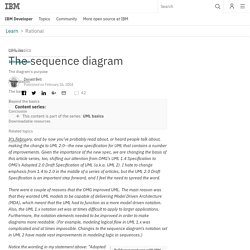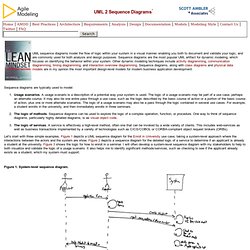

Sequence diagram. Sequence diagram of e-mail message sequence A sequence diagram is an interaction diagram that shows how processes operate with one another and in what order.

It is a construct of a Message Sequence Chart. A sequence diagram shows object interactions arranged in time sequence. It depicts the objects and classes involved in the scenario and the sequence of messages exchanged between the objects needed to carry out the functionality of the scenario. Sequence diagrams are typically associated with use case realizations in the Logical View of the system under development. A sequence diagram shows, as parallel vertical lines (lifelines), different processes or objects that live simultaneously, and, as horizontal arrows, the messages exchanged between them, in the order in which they occur. Diagram building blocks[edit] If the lifeline is that of an object, it demonstrates a role.
UML has introduced significant improvements to the capabilities of sequence diagrams. References[edit] UML basics: The sequence diagram. UML basics Donald BellPublished on February 16, 2004 It's February, and by now you've probably read about, or heard people talk about, making the change to UML 2.0--the new specification for UML that contains a number of improvements.

Given the importance of the new spec, we are changing the basis of this article series, too, shifting our attention from OMG's UML 1.4 Specification to OMG's Adopted 2.0 Draft Specification of UML (a.k.a. UML 2). I hate to change emphasis from 1.4 to 2.0 in the middle of a series of articles, but the UML 2.0 Draft Specification is an important step forward, and I feel the need to spread the word.
There were a couple of reasons that the OMG improved UML. Build your next app with IBM Cloud Lite It's free. Notice the wording in my statement above: "Adopted 2.0 Draft Specification of UML. " The main purpose of this article is to continue our focus on the essential UML diagrams; this month, we take a close look at the sequence diagram. The diagram's purpose Messages. Introduction to UML 2 Sequence Diagrams. Sequence diagrams are typically used to model: Usage scenarios.

A usage scenario is a description of a potential way your system is used. The logic of a usage scenario may be part of a use case, perhaps an alternate course. It may also be one entire pass through a use case, such as the logic described by the basic course of action or a portion of the basic course of action, plus one or more alternate scenarios. The logic of a usage scenario may also be a pass through the logic contained in several use cases. Let's start with three simple examples. Figure 1. The reason why they're called sequence diagrams should be obvious: the sequential nature of the logic is shown via the ordering of the messages (the horizontal arrows). Figure 2. The boxes across the top of the diagram represent classifiers or their instances, typically use cases, objects, classes, or actors.
Figure 3. Figure 4 presents a complex UML sequence diagram for the basic course of action for the Enroll in Seminar use case.